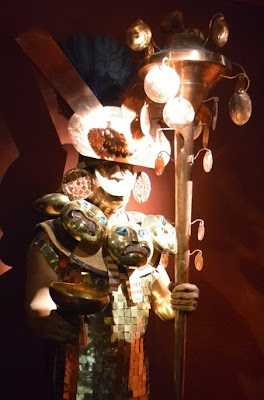Wednesday, November 27, 2013
Neal Bierling, Archaeological Adventures: Getting High in Peru: The Lords of Sipan, Part 2
Neal Bierling, Archaeological Adventures: Getting High in Peru: The Lords of Sipan, Part 2: Getting High in Peru: The Museo de Sitio, Huaca Rajada—Sipan, Part 2 In my previous posting on the pre-Inca Sipan culture, ...
Getting High in Peru: The Lords of Sipan, Part 2
Getting
High in Peru: The Museo de Sitio, Huaca Rajada—Sipan, Part 2
In my previous posting on the pre-Inca Sipan
culture, my focus was on the capital site, the center of the Sipan culture at
Huaca (Temple) Rajada. Out in the field at the Huaca Rajada, the staff of Museo
de Sitio did an excellent job in providing reconstructions of the tombs with
replica skeletons and replica artifacts. I did show a number of authentic artifacts
from the on-site museum, but now my focus will be on the other offerings of the
museum. Some of what I show might be a bit macabre, but the museum does offer
the visitor a unique glimpse into what was recovered and how it would look as
if you were the excavator.
A brief review: the Moche thrived along the northern
coast of what is now Peru along the river valleys from AD 100 to 700. They were
the truncated-pyramid, platform master builders, expert at irrigation
techniques, metallurgy, ceramics, developing trade with other cultures thus
allowing their elite (the lords and others) to store quantities of ceramic
jars, precious metals and stones in their tombs in preparation for the
afterlife.
 |
| Close up of the reconstructed tomb using replicas. |
Below are two views of skeletal remains of one
individual with its copper artifacts accompanying the deceased and below him
are other skeletal remains and ceramic offerings.
Here is the close up of the reconstructed tomb for what follows
 |
| The gilded-copper plates added to a tunic as in the below drawing |
Just above is the priest wearing a gilded-copper tunic and wearing or carrying other
gilded objects displayed in the coffin above. In his left hand is a ceremonial
war club, and his right hand is holding a bowl, which originally may have
contained the blood of a sacrificial victim.
In
the previous posting, I showed the on-site reconstruction of the Lord of
Sipan’s Tomb. The guardian of his tomb was buried at a higher level. Below are
his skeletal remains. Note that his feet are missing. It is surmised that this
was done to ensure that he would not leave his job as guardian.
 |
| Note this elite’s headgear, his ear ornaments, and his expansive necklace. The Old Lord of Sipan was dressed in a similar fashion but with finer gold and gilded-copper gear. |
 |
| Focus on the necklace |
 |
| Focus on the headgear |
 |
| I forgot to photograph the nose gear |
 |
| These two burials were not as rich as were the Lords of Sipan or other members of the elite, but they were buried in cane coffins. |
 |
|
This Sipan jar is
classified as Late Moche and is definitely not as well-crafted as their earlier
forms.
|
The archaeologists were digging stratigraphically,
meaning that they were removing the soil with its artifacts layer by layer.
Directly above the Sipan culture was a more recent Lambayeque culture burial(s)
and the museum included some examples. The
Lambayeques are equated by some as Chimu.
 |
|
Lambayeque skeletal
remains with some grave goods and examples of their ceramics, copper, and shell
trade below.
|
 |
|
Above the Lambayeque
layer were the Chimu and here are the skeletal remains plus grave goods of a
Chimu.
|
Of course, the archaeologists as they dug down layer
by layer first uncovered the Chimu-Inca burials, followed by the Chimu, then
the Lambayeque, the Late Moche, and in the lowest burials in the ground were
the Classical Moche highlighted in my postings of Sipan and Chan-Chan as
examples. The Chart below focuses on Sipan in the left column followed by to the right of two other
regions where the Moche also thrived for at least 600 hundred years.
In the previous posting of Sipan I mentioned Walter
Alva’s book, Sipan, where he
describes his twenty years of excavation at the Huaca Rajada. It was due to the
discovery of looting at the Huaca back in 1987, that he began his salvage
excavation there, followed by a full-scale excavation. Near the end he of the
book he describes how beginning in 1996-97, with the aid of US governmental
agencies, he and Peru were able to recover artifacts found in the hands of Los
Angeles collectors, on sale at Sotheby’s in New York, and then the FBI
recovered more in Philadelphia.
The
poster below, which I photographed at the on-site museum, is also reproduced in
his book features recovered artifacts.
A gilded-copper feline mask similar to the one
featured on the façade of the on-site museum was recovered in cargo confiscated
in Miami highlighted in the above close up. What happened to some of Peru’s
cultural treasures is, sad to say, a problem all over the world. Peru has been
fortunate to recover some of their cultural heritage.
Below
are the final photographs showing the Royal Tombs of Sipan Museum which
attempts to emulate the truncated-pyramid shape of the Huacas and you enter
(without cameras) via the ramp and then once inside you descend to the
different levels of time.
Paz y Shalom from Neal Bierling
Subscribe to:
Comments (Atom)


















